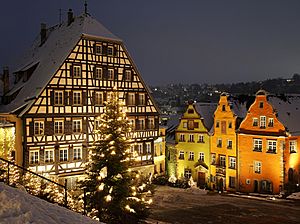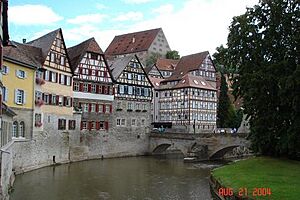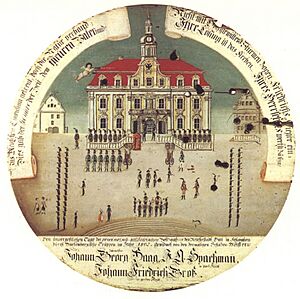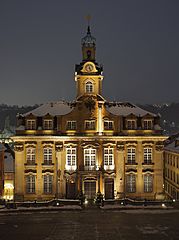Schwäbisch Hall facts for kids
Quick facts for kids
Schwäbisch Hall
|
||
|---|---|---|

Marktplatz at Christmas time
|
||
|
||
| Country | Germany | |
| State | Baden-Württemberg | |
| Admin. region | Stuttgart | |
| District | Schwäbisch Hall | |
| Elevation | 304 m (997 ft) | |
| Population
(2022-12-31)
|
||
| • Total | 41,898 | |
| Time zone | CET/CEST (UTC+1/+2) | |
| Postal codes |
74523
|
|
| Dialling codes | 0791, 07907 (Sulzdorf, Tüngental), 07977 (Sittenhardt, Wielandsweiler) | |
| Vehicle registration | SHA, CR | |
| Website | www.schwaebischhall.de | |
Schwäbisch Hall is a city in the German state of Baden-Württemberg. It lies in the beautiful valley of the Kocher river, which flows into the Neckar river. The city is located northeast of Stuttgart, the state capital, and is close to Heilbronn. Schwäbisch Hall is also the main city of the Schwäbisch Hall district.
Even though its name includes "Schwäbisch" (meaning "Swabian"), the city is actually in a region called Heilbronn-Franconia. This area is more like Franconia in Bavaria in its culture and language.
The city is famous for its historic market square, home to St. Michael's Church (St. Michaelskirche). Other important places include Comburg Castle, which used to be a monastery, and the Hällisch-Fränkisches Museum. This museum tells the story of Schwäbisch Hall and the surrounding Franconian region. For about 500 years, Schwäbisch Hall was a Free Imperial City within the Holy Roman Empire. This meant it was independent and ruled itself. In 1802, it became part of Württemberg.
Contents
What's in a Name?
The first part of the name, "Schwäbisch," refers to the Swabian League, a group of states and cities in the past. The second part, "Hall," has a less clear origin. It might come from an old German word meaning "drying something by heating it." This could refer to how salt was made here for a very long time, by heating salty water until the water evaporated. The saltworks in Schwäbisch Hall closed down in 1925.
A Look at History
Early Beginnings
People were making salt from salty water in Schwäbisch Hall as far back as 500 BCE. The Celts, an ancient people, were the first to do this.
The town was first mentioned in a document from 1063. It likely belonged to the Counts of Comburg-Rothenburg before becoming part of the Hohenstaufen family's lands around 1116. It was probably Emperor Frederick I who started the imperial mint here, making the famous "Heller" coins. Schwäbisch Hall grew rich from making both salt and coins. By 1204, it was officially called a town.
After the Hohenstaufen family lost power, Schwäbisch Hall successfully defended itself against local nobles. In 1280, this conflict was settled, allowing the town to become a Free Imperial City. This meant it was a self-governing city within the Holy Roman Empire. In 1340, Emperor Louis IV gave the city a new set of rules to help solve internal disagreements. The city was then run by an "Inner Council" made up of noblemen, middle-class citizens, and craftsmen. The head of the council was called the Stättmeister (mayor).
Later, around 1510-1512, another period of disagreements ended the strong power of the noble families. A new group of leading families took charge. The Bonhöffers, ancestors of the famous theologian Dietrich Bonhoeffer, were among them.
Middle Ages and Beyond
From the 1300s to the 1500s, Schwäbisch Hall gained a lot of land around it. This wealth can still be seen in buildings like St. Michael's Church, which was rebuilt between 1427 and 1526 and has an impressive stairway from 1507. The city quickly joined the Protestant Reformation. Johannes Brenz, a follower of Martin Luther, became a pastor in 1522 and helped change the church and school system to follow Lutheran ideas.
The city suffered greatly during the Thirty Years' War (1618-1648). Even though it was not attacked directly, it had to pay huge amounts of money to different armies. Soldiers also caused a lot of damage and stole from the city and nearby areas. Between 1634 and 1638, one out of every five people died from hunger and sickness, especially the bubonic plague. The war left the city poor and its economy ruined. However, by reorganizing salt production and trade, and with growing wine trade, the city recovered surprisingly fast.
From the 17th Century to the Early 1900s
Fires were a constant danger because most houses were made of wood. Big fires in 1680 and especially in 1728 destroyed much of the city. This led to new buildings being built in the Baroque style, like the city hall.
The Napoleonic wars brought an end to Schwäbisch Hall's time as a Free Imperial City. In 1802, Napoleon allowed the Duke of Württemberg to take over the city. Schwäbisch Hall lost its land and its independence, becoming a smaller administrative center. The state also took over the salt works.
A long economic downturn in the 1800s caused many people to move away, often to other parts of Germany or to the United States. While other towns grew with the Industrial Revolution, Schwäbisch Hall's population stayed the same. The economy improved in the second half of the 1800s, especially after a railway line to Heilbronn was built in 1862. However, the city did not grow much until the 1920s and 1930s, when new areas were built around the old town. Hall also grew by adding nearby villages like Steinbach (1930) and Hessental (1936).
In 1827, a health spa was opened on an island in the Kocher river. This spa became very important for the economy, especially after the railway was built. The well-preserved old town also attracted more and more tourists. Since the early 1900s, Schwäbisch Hall has hosted many festivals. The outdoor theater shows on the steps of St. Michael's Church are especially well known.
Nazi Germany and World War II
In 1934, the city was officially named Schwäbisch Hall. During the Third Reich, an air base for the German air force (Luftwaffe) was built at Hessental. On November 9, 1938, during an event known as Kristallnacht, local Nazis burned the synagogue in Steinbach and damaged Jewish shops and homes. About 40 Jewish citizens from Schwäbisch Hall were killed in concentration camps during the Holocaust. In 1944, a concentration camp was set up near the Hall-Hessental train station.
The train station in Hall was bombed by American planes on February 23, 1945. Most of the damage was in the suburbs. On April 17, 1945, US Army troops took over the city without much fighting. Although some buildings were damaged, the historic old town remained mostly intact.
After World War II
In 1960, Schwäbisch Hall became a "Große Kreisstadt." This means the city took on some of the tasks usually handled by the district. After World War II and until the end of the Cold War, the US Army had military bases in Schwäbisch Hall. These bases were returned to German control in 1993.
Who Lives Here?
As of December 31, 2009, Schwäbisch Hall had 36,799 people living there. These residents came from over 100 different countries. In 2017, the population grew to over 39,000 people.
Weather in Schwäbisch Hall
| Climate data for Schwäbisch Hall (1991-2020) | |||||||||||||
|---|---|---|---|---|---|---|---|---|---|---|---|---|---|
| Month | Jan | Feb | Mar | Apr | May | Jun | Jul | Aug | Sep | Oct | Nov | Dec | Year |
| Daily mean °C (°F) | 1.1 (34.0) |
1.8 (35.2) |
5.4 (41.7) |
9.7 (49.5) |
13.7 (56.7) |
17.2 (63.0) |
19.0 (66.2) |
18.6 (65.5) |
14.2 (57.6) |
9.6 (49.3) |
5.0 (41.0) |
1.9 (35.4) |
9.8 (49.6) |
| Average precipitation mm (inches) | 74 (2.9) |
65 (2.6) |
71 (2.8) |
51 (2.0) |
80 (3.1) |
78 (3.1) |
89 (3.5) |
71 (2.8) |
59 (2.3) |
75 (3.0) |
70 (2.8) |
89 (3.5) |
872 (34.4) |
| Mean monthly sunshine hours | 55.7 | 81.9 | 134.3 | 185 | 210.7 | 225.6 | 240.4 | 226.1 | 168.2 | 110.1 | 59 | 45.5 | 1,742.5 |
| Source: Deutscher Wetterdienst | |||||||||||||
Buildings and Design
Schwäbisch Hall has a mix of old and new buildings. In the city center, you'll find many medieval buildings, often with Timber Frame (wood-framed) walls, and others in Gothic and Baroque styles. Newer buildings are mostly found on the edges and in the suburbs. This helps to keep the historic look of the city center.
Fun Things to Do
Schwäbisch Hall has an outdoor summer theater that performs on the steps of St. Michael's Church and at the Globe Theatre. The Hällisch-Frankische Museum and the Hohenloher Freilandmuseum (an open-air museum) show the history of the region from the Middle Ages.
The Kunsthalle Würth is a modern art gallery where you can see paintings, drawings, and sculptures from the 1800s onwards. Schwäbisch Hall and the areas around it offer many fun activities like sports flying, swimming, hiking, and cycling.
Other cultural events in the city include the Salt Festival, which celebrates the city's history of salt production. There's also the Summer Night Festival, the Baker's Oven Festival, and a Christmas Market with traditional crafts.
Learning and Schools
Schwäbisch Hall has a long history as a place for learning. The city offers many educational chances through vocational schools and technical schools. These schools offer programs in social work, nursing, and even Ayurvedic teaching.
Because there is a branch of the Goethe-Institut in Schwäbisch Hall, up to 2,000 students from all over the world come here each year to learn German. These programs are very popular in the summer, especially with college students who want to improve their German during their break.
The City Archives Hall is a center for historical research. It collects, organizes, and manages old records and collections related to the city's history. This includes photos, posters, maps, and old newspapers. The archive also has many books about the history of Schwäbisch Hall and the region.
Economy and Jobs
Schwäbisch Hall is an important economic center in its region, located between big cities like Frankfurt, Stuttgart, and Nuremberg. In the past, salt was the most important product. Today, the economy is driven by many medium-sized companies, mainly in trade and services. Several businesses dealing with property finance, solar energy, and telecommunications also have their main offices here.
Two well-known companies are Bausparkasse Schwäbisch Hall AG, a company that helps people save for homes, founded in 1944. Another is Recaro Aircraft Seating, which makes seats for airplanes.
Students from the Goethe-Institut contribute to the local economy, staying in hotels for up to 600 nights each year.
Getting Around
Roads
Schwäbisch Hall has an exit on the Autobahn 6, a major highway connecting Heilbronn and Nürnberg. Federal highways 14 (Stuttgart–Nürnberg) and 19 (Ulm–Aalen–Schwäbisch Hall–Würzburg) also pass through the city.
Railways
The city has two train stations. Schwäbisch Hall-Hessental station is a junction for trains going between Waiblingen and Schwäbisch Hall, and between Crailsheim and Heilbronn. Schwäbisch Hall station (the city station) is on the Crailsheim–Heilbronn railway line.
Aviation
There are two small airfields near the city. Weckrieden (EDTX) is a grass airfield for recreational flying. Adolf Würth Airport (EDTY) is mainly used by the Würth group of companies for their business jets. Neither offers regular passenger flights.
Sports and Activities
In Schwäbisch Hall, you can play many sports, including swimming, track and field, tennis, shooting, soccer, baseball, handball, and American football. The city has 22 sports halls and 25 outdoor playing fields. The Schwäbisch Hall Unicorns are a very successful German American football team, winning national championships in 2011 and 2012. A famous player, Moritz Böhringer, who later played in the NFL, used to play for the Unicorns.
Partner Cities
Schwäbisch Hall has "twin towns" or "sister cities" around the world. This means they have special friendly relationships and often exchange visits and ideas.
 Épinal, France (since 1964)
Épinal, France (since 1964) Loughborough, England, United Kingdom (since 1966)
Loughborough, England, United Kingdom (since 1966) Lappeenranta, Finland (since 1985)
Lappeenranta, Finland (since 1985) Neustrelitz, Germany (since 1988)
Neustrelitz, Germany (since 1988) Zamość, Poland (since 1989)
Zamość, Poland (since 1989) Balıkesir, Turkey (since 2006)
Balıkesir, Turkey (since 2006) Rasht, Iran (since 2016)
Rasht, Iran (since 2016)
Famous People from Schwäbisch Hall
- Melchior Hofmann (around 1500–1543), an important leader in the Anabaptist religious movement.
- Thomas Schweicker (1540–1602), an amazing artist who created his art using his feet because he had no arms.
- Johann Ulrich Steigleder (1593–1635), a composer and organ player from the Baroque period.
- Friedrich David Gräter (1768–1830), one of the people who started the study of Scandinavian languages and German history of language.
- Prince Frederick of Württemberg (1808–1870), a prince from the House of Württemberg royal family.
- Louis Braun (1836–1916), a painter known for his battle scenes.
- Otto Ruff (1871–1939), a famous chemist who studied fluorine.
- Maria Kiene (1889–1979), a teacher and head of a child welfare organization.
- Walter Haeussermann (1914 in Künzelsau – 2010), a German-American aerospace engineer and physicist.
- Hans Beißwenger (1916–1943), a pilot in the German air force during WWII.
- Wolfgang Gönnenwein (1933–2015), a conductor and music teacher.
- Kraft, Prince of Hohenlohe-Langenburg (1935–2004), the ninth head of the Hohenlohe-Langenburg noble family.
- Princess Beatrix of Hohenlohe-Langenburg (1936–1997), a princess from the Hohenlohe-Langenburg family.
- Joachim Rücker (born 1951), a diplomat.
- Susanne Erding-Swiridoff (born 1955), a composer and curator.
- Bettina Würth (born 1961), a Swiss billionaire businesswoman from the Würth Group.
- Hartmut Abendschein (born 1969), a German-Swiss writer.
- Heinrich Schmieder (1970–2010), an actor.
Sports Stars
- Marco Sailer (born 1985), a footballer who played over 310 games.
- Tobias Weis (born 1985), a footballer who played 226 games.
- Louk Sorensen (born 1985), an Irish former tennis player.
- Jonas Koch (born 1993), a cyclist.
See also
 In Spanish: Schwäbisch Hall para niños
In Spanish: Schwäbisch Hall para niños










